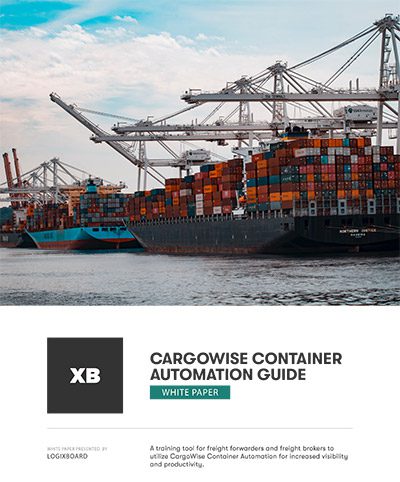FREE CARGOWISE CONTAINER AUTOMATION TRAINING GUIDE
Downloadable Guide to Container Shipment Visibility and Automation with CargoWise
Download Now
A training tool for freight forwarders and freight brokers to utilize CargoWise Container Automation for increased visibility and productivity within their operations.
A training tool for freight forwarders and freight brokers to utilize CargoWise Container Automation for increased visibility and productivity within their operations.
In this guide, we dive deeper into:
- How to utilize the module
- Container events and automations available
- CargoWise Container Automation FAQ

Inside this free CargoWise Container Automation Guide:
INTRODUCTION TO CARGOWISE CONTAINER AUTOMATION
CargoWise’s Container Automation module released in 2019 and assists in the management of containerized cargo. This module is preprogrammed to apply to all containers that have the required data/information needed to track the shipment – no opt in is needed by CargoWise users.
Regardless of who the customer is in the supply chain (importer, broker, co-loader,etc.), the containers are automatically tracked through their journey once the data requirements for the module are met.
Container Automation events and statuses are deeply integrated within CargoWise operational jobs. They provide the ability to set up resulting actions to occur automatically for every event or status through workflow triggers. The container automation module also receives vessel statuses (e.g. “6 hours from port”) – allowing you to better plan transportation and warehousing of cargo.
HOW TO SETUP CARGOWISE CONTAINER AUTOMATION
You only need to have one piece of data correctly inputted for your containerized shipment to automatically trigger the CargoWise Container Automation module. When first created you needed both of the following, but CargoWise improvements now look up the carrier’s name if the SCAC is not inputted.
Co-loads, or less than container loads (LCL), are close to a “ride sharing” option for freight transportation. Shipments from multiple companies are consolidated on the same transportation vehicles, and in this case the same containers. CargoWise’s Container Automation supports event management and visibility for co-loads/LCLs at the vessel level for the whole container, but not the delivery or unpack statuses. To avoid tracking unrelated containers on the same ocean Bill of Lading, co-loaded orders will need to input the following data.
WHAT IS CARGOWISE EVENT AUTOMATION
As digitization sweeps the industry, using digital solutions to aid forwarding professionals in the efficiency and productivity of shipment workflows has continued to be a top priority for many companies. CargoWise training for a forwarding operations team is not complete without the understanding of the Container Automation features. Removing the manual work of tracking and updating customers on their containerized cargo benefits all parties involved.
As with CargoWise’s vessel level tracking and automation, this module lets operations set up milestones of a container’s journey based on their own SOPs. As events and milestones are reached, automatic communications can be sent to customers to inform them of what legs of the journey have been completed, when they were completed, and any new estimated arrival times based on changes in this schedule.
Every forwarding operation has their own procedures and slight differences on how they manage a customer’s shipment throughout its journey, but the uniform container-level milestones can be set up to progress the job without interference (when exceptions aren’t applicable).
UTILIZING THE CARGOWISE CONTAINER AUTOMATION MODULE
Most logistics professionals using CargoWise are not using container level workflow, or at least not properly. Having this module set up properly puts organizations at a place to leverage the resulting visibility, productivity, and efficiency to differentiate their services from the competition. Every CargoWise user is automatically enrolled in CargoWise Container Automation, but the real potential of this module is not seen without the conscious effort to understand and utilize its capabilities for your team.